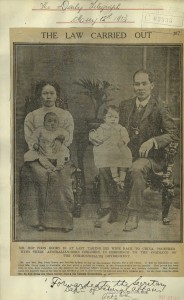The Canberra Times this morning is reporting the destruction of an 1850s building that was once used by the Chinese family, the Nomchongs. The single-storey wooden building stood in the main street of heritage-listed Braidwood, near Canberra and was demolished apparently in error. The Canberra Times says that the demolition was approved by the local Palerang Council, but there had been a mix-up over the address of the building.
The Nomchong brothers first settled in Braidwood in the 1860s–70s, and the descendants of one of the brothers still live and run businesses in the town today. The first Nomchong in the Braidwood area was Sheong Foon Nomchong (his name was spelt in a range of ways), who established a business at Mongarlowe and then Braidwood, and married Ellen Lupton, a woman of Irish-English descent. As his business grew he called for his brother Chee Doc to come to Australia from California. It is Chee Doc’s descendants who remain in the area today.
Read the Canberra Times article:
Historic Braidwood building’s ‘appalling’ demolition by Megan Doherty
More on the Nomchong family:
Shoon Foon Nom Chong from the Golden Threads database
Chee Doc Nom Chong from the Golden Threads database
Golden Threads also lists objects and sites associated with the Nomchong family in the Braidwood area.
The National Library of Australia holds the Nomchong family photograph collection (PIC/7659), the photographs from which are digitised and can be viewed online. The NLA also has oral history interviews with Nomchong family members.
The National Archives of Australia has a range of records about various members of the Nomchong family, including war service records, naturalisation applications and files relating to migration to Australia and travel out of Australia. Some of these can be found in the RecordSearch database by doing a keyword search for ‘nom chong’ or ‘nomchong’.
The Braidwood Historical Society has a collection of Nomchong family material, including the ‘Nomchong Room’ at the Braidwood Museum (Wallace Street, Braidwood).
And more generally on the history of the Chinese, including the Nomchongs, in the Braidwood area, see the extensive work of Dr Barry McGowan.

